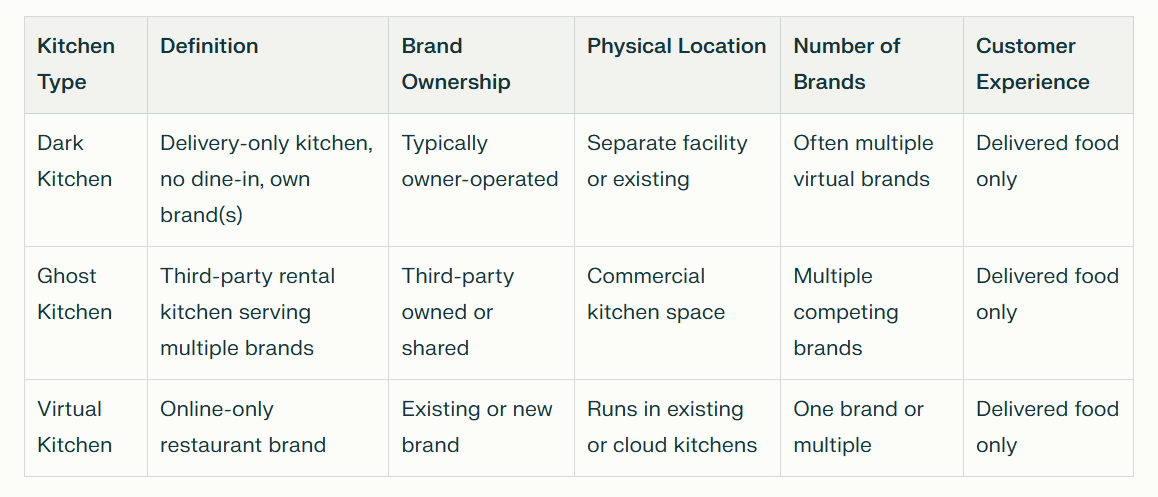The food delivery landscape is full of terms that sound alike but mean very different things: dark kitchen, ghost kitchen, virtual kitchen. Getting these right changes how you approach your business or understand the market. Here’s the deep dive you asked for – clear definitions, compelling examples, and guidance on what makes each model tick.
Dark Kitchen
This is a no-frills kitchen dedicated exclusively to delivery. No diners, no storefront, the food doesn’t meet customers face-to-face. Usually owned by a single operator, dark kitchens often juggle several virtual brands under one roof. Locations? Often tucked away in underused commercial spaces – industrial districts far from the dining crowds. The goal: high-volume production, low overhead, and laser focus on online orders.
Ghost Kitchen
A ghost kitchen is like a shared office space, but for restaurants. Multiple unrelated brands rent kitchen time and space, sometimes competing in the same physical location. These kitchens have no walk-in customers and work entirely for delivery. The key difference: they operate independently of traditional restaurants, acting as rental hubs turning kitchen space into a service.
Virtual Kitchen
Virtual kitchens are the branding layer on top; brands that exist only online, with no physical dining space. They often use dark or ghost kitchens to cook, but they have their own distinct menus and marketing, often launched to experiment with new concepts or target a niche audience without expanding real estate.

1. Build for clarity, not complexity.
Most ghost kitchens collapse under their own systems. Too many tablets, too many logins, too many apps doing the same thing. Start by centralizing everything – orders, menus, reporting – into one dashboard. The goal is to make operations boringly predictable, not excitingly chaotic.
2. Keep your menu tight (and synced).
Your best menu isn’t the biggest one. Focus on a small set of items that travel well and can be prepped fast. Use unified menu management so every change automatically updates across delivery platforms – no more outdated prices or missing modifiers.
3. Automate your order flow.
Manual re-entry kills speed and accuracy. Use direct integrations between your delivery apps and POS to push orders straight to the kitchen in real time. The less your staff has to touch a screen, the fewer mistakes you’ll make.
4. Treat data like an ingredient.
Track which dishes perform best on each platform, and use that insight to refine pricing, timing, and promotions. Ghost kitchens thrive on agility – data is how you know when to pivot.
5. Simplify onboarding for new brands.
Launching a new virtual brand shouldn’t take weeks of setup. Standardize your process – shared ingredients, reusable menu templates, and self-service integration tools will help you scale faster without adding complexity.
6. Keep your human touch.
Just because the business is digital doesn’t mean it should feel robotic. Add small, consistent touches – branded packaging, handwritten notes, fast customer response times. These details build loyalty in a world with no face-to-face interaction.
Ghost kitchens typically operate with lower overhead – no front-of-house staff or dine-in facilities – and generate profit margins around 15%, with monthly revenues varying from $50,000 to $150,000 or more depending on scale and location. The global cloud kitchen market is projected to grow from around $82 billion in 2025 to $225 billion by 2034, fueled by consumer demand and technological advancements.
Niche ghost, cloud, and dark kitchens
- Rebel Foods (Faasos, Oven Story, Bombay Salad Co.)
Though originally Indian, Rebel Foods expanded into the U.S. with virtual brands focusing on regional and fusion cuisines. They operate numerous delivery-only brands via cloud kitchens.
- Nextbite
Nextbite partners with existing restaurants and operators to turn their kitchens into delivery-only brands targeting niche markets like comfort foods and regional specialties. They run brands like The Fry Co., Vegan Boke, and others.
- Ding Dog
A virtual brand by whom do you think? Uniliver. Being not the most ethical company for decades, they've been changing their worikng traectory for good. If you are into plant-based future, check them out.
It feels like you might like this article – "How to start your virtual brand".




